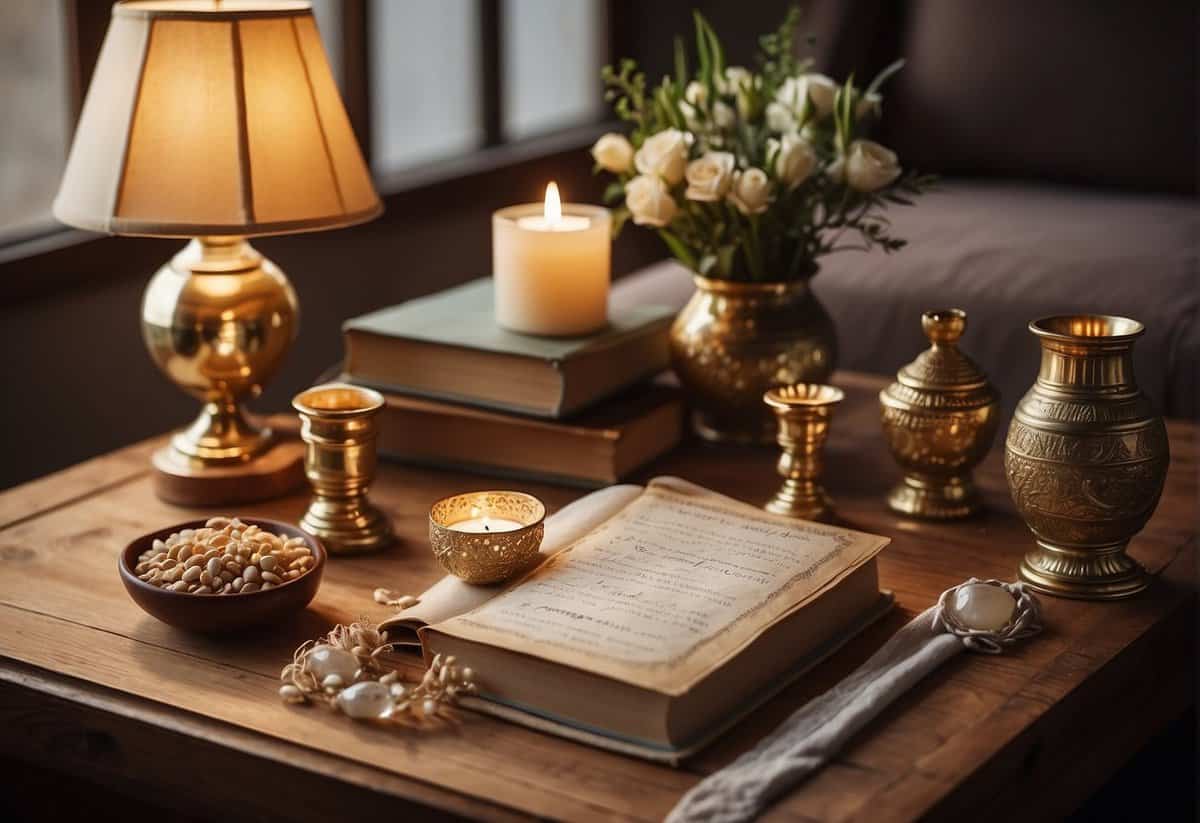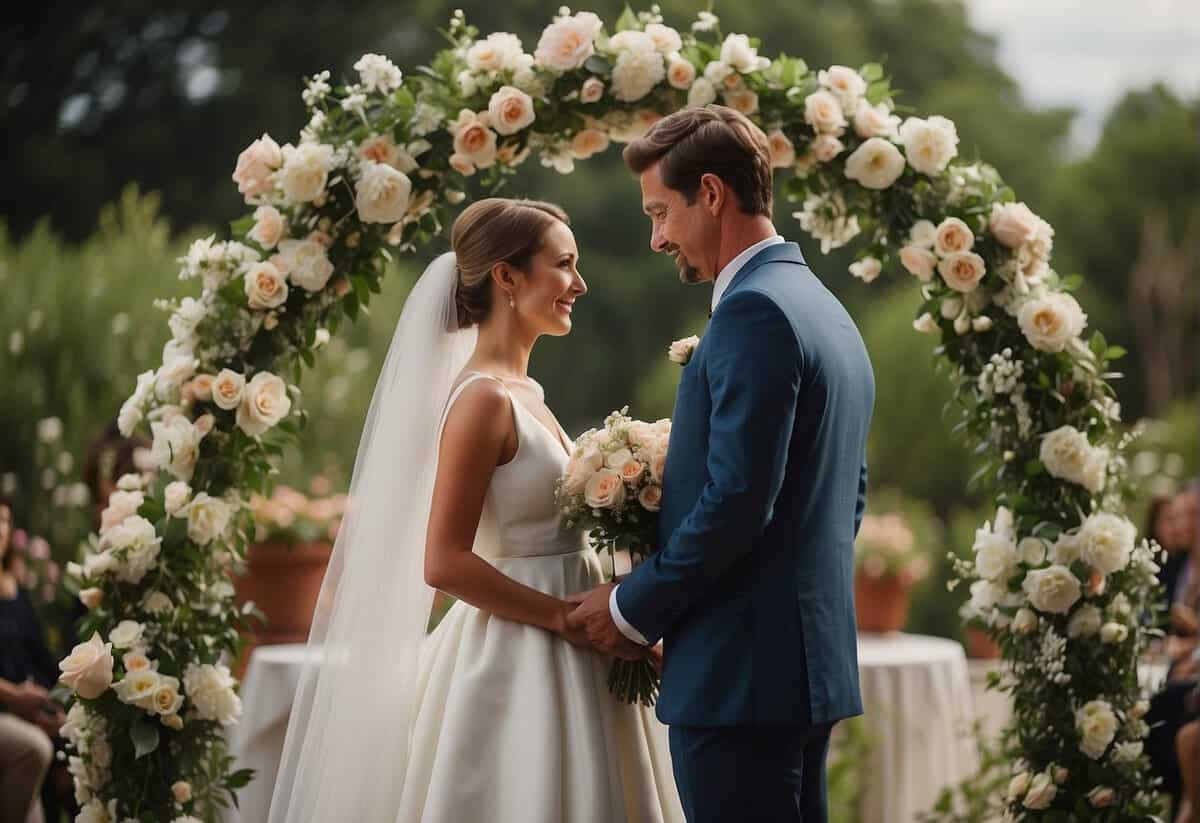What Are the Seven Vows of Marriage? Understanding Their Meaning and Significance
In Hindu marriages, the seven vows, also known as Saptapadi, play a crucial role in binding a couple together. During a traditional Hindu wedding ceremony, the bride and groom walk around the sacred fire, typically seven times, with each circumambulation representing a vow they make to each other. These vows are not mere promises but are profound principles meant to guide the couple through their married life, touching upon various aspects such as prosperity, health, and mutual respect.

Each of these vows carries specific significance and expectations, ensuring that the couple pledges to support and love each other under all circumstances. They form the spiritual core of a Hindu wedding and aim to unite the couple in a journey of mutual growth and understanding. The vows are considered sacred, and observing them throughout the marriage is expected.
Key Takeaways
- The seven vows of marriage are integral to Hindu weddings, symbolizing a lifelong commitment.
- The vows address various aspects of life, emphasizing support, love, and mutual respect.
- Observing these vows is a spiritual journey for the couple, signifying their unity and adherence to tradition.
The Significance of the Seven Vows

The seven vows in a Hindu wedding, known as the Saptapadi, are cornerstones that establish a compassionate and reciprocal relationship. Each vow serves as a step to guide the bride and groom through a shared life of dharma, love, and commitment.
Vows and the Hindu Wedding Ceremony
In a Hindu wedding, the seven vows are taken while the couple circulates the sacred fire, a ritual called Phera. Each round around the fire symbolizes a specific promise made by the couple to each other to fulfill duties towards their family and the gods.
Cultural and Spiritual Dimensions
The seven vows are deeply imbued with the cultural and spiritual ethos of the Hindu religion. They are recited in Sanskrit, reflecting not just a marital union but a bond that aligns with cosmic laws and the blessings of divine forces.
Roles and Responsibilities in Marriage
Your acceptance of the seven vows signals a mutual understanding of roles and responsibilities within the marriage. Dharma, Artha, Kama, and Moksha are the four pillars that the couple uphold together, balancing spiritual and worldly duties.
Prosperity and Well-being
Prosperity and well-being are central to the vows, emphasizing that both bride and groom work together for the wealth and happiness of their new family. By supporting each other’s goals, you lay foundations for a future filled with abundance.
Milestones and Transition Into Family Life
As you take these vows, you acknowledge the significant milestones ahead. Transitioning into family life means embracing changes and growing to meet each phase of life together with strength and support.
Eternal Bonds and Lifelong Commitment
The saptapadi ritual encapsulates an eternal bond and a lifelong commitment. Your promises are not for the moment, but for a lifetime of trust and union, creating an unbreakable bond well beyond the wedding ceremony.
Advancing Together Through Life
These vows are not merely words but commitments to advance together through life, face challenges with courage, and draw on each other’s knowledge and education to make wise decisions.
The Phera Ritual and Its Significance
The phera ritual, also known as saat phere or mangal pheras, is significant as it physically and symbolically represents the journey of marriage. With each step, you commit to a shared path of harmony and relationship building.
Unique Regional Practices
Though the core essence of the vows remains consistent, unique regional practices add diversity to the tradition. In South India and North India alike, nuances in the rituals like Gujarati weddings introduce different mantras and customs reflecting richness and variety.
Global Influence and Adaptation
The tenets of the seven vows have found a place in the global landscape. With international adaptation, the essence of these vows transcends cultural boundaries, guiding couples worldwide on the principles of unity and friendship in marriage.
Understanding the Individual Vows

The seven vows of marriage symbolize the framework upon which a successful and harmonious union is built. Each vow corresponds to a key aspect of life and the mutual commitment you and your partner make to each other.
First Vow
In the First Vow, you promise nourishment and support to one another. You commit to providing welfare and happiness for your family, a pledge that sets the tone for a prosperous life together.
Second Vow
The Second Vow emphasizes the importance of strength and courage. You vow to protect each other and your future children, promising loyalty through life’s challenges.
Third Vow
With the Third Vow, you agree to earn wealth through honest means and share it. This vow lays the foundation for financial security and prosperity, ensuring success in your endeavors.
Fourth Vow
In this vow, you both seek gratitude and longevity through health and well-being practices. The Fourth Vow is about cherishing life and ensuring the longevity of your relationship.
Fifth Vow
Here, the Fifth Vow focuses on the offspring, pledging to raise strong, virtuous children and to maintain a home of learning, respect, and virtue.
Sixth Vow
The Sixth Vow entails maintaining a trust and devotion that are as unwavering as the seasons. It’s a promise of loyalty and friendship solidified through loyalty and bearing witness to each other’s lives.
Seventh Vow
Finally, the Seventh Vow seals the commitment with a promise of love and affection. It is the ultimate vow of unwavering loyalty, devotion, and mutual respect that embodies the spirit of true friendship and everlasting love.
The Modern Context of Hindu Marriage Vows

When you think about Hindu marriage vows today, consider how they blend timeless tradition with the perspectives and values of modern society. These ancient promises take on a fresh significance in contemporary weddings, balancing cultural heritage with modern ideals of equality and partnership.
The Relevance in Today’s Society
In your everyday hustle, you may wonder how centuries-old vows fit into current realities. The core principles of these Saat Pheras, or seven vows, such as love, mutual respect, and commitment, continue to form the foundation of marriages. Despite the evolution of societal norms, these values are as critical today as they were generations ago.
Interpreting Vows in the Context of Equality
The interpretation of vows in modern Hindu weddings has seen a shift towards equality. As you and your partner recite the promises, there’s a growing emphasis on mutual respect and support. Instead of adhering to traditional gender roles, you’re likely to pledge for an equal partnership in nurturing family and pursuing shared goals.
Incorporating Tradition into Modern Weddings
In a world where you’re constantly searching for authentic experiences, incorporating traditional elements into your modern wedding can be both meaningful and fashionable. Whether it’s the rituals, the attire, or the vows themselves, you’re provided with an opportunity to honor your cultural heritage while celebrating your individuality.
Educating Future Generations
By including these ancient customs in your wedding, you become part of educating future generations. Your family and friends witness a beautiful blend of time-honored practices with contemporary views—this not only adds depth to your special day but also helps instill wisdom and appreciation for tradition in younger family members.
Preparation and Participation in the Wedding Ceremony

In the vibrant tapestry of a Vedic wedding ceremony, your role is not just as a spectator but as an integral part of the rituals that unite two individuals. Your presence and actions—all steeped in tradition—help shape the sanctity and success of the marriage.
Role of Family and Friends
Your support as a family member or friend is more than just attending the ceremonies; it’s about providing emotional encouragement and assistance. From sharing wisdom to helping with pre-wedding rituals, your role is crucial in preparing the couple for their life together, ensuring they step into marriage with the right intentions and blessings.
Arranging the Sacred Space
The creation of the mandap, a temporarily-erected sacred structure, is a communal effort, symbolizing the importance of the community in the marriage system. This space often includes a holy fire or agni, which serves as a witness to the marriage vows.
Pre-Wedding Rituals and Significance
Various pre-wedding rituals mark the commencement of a successful married life. Each ritual, imbued with dharma (duty) and artha (means), is designed to prepare you, the couple, for a life of kama (pleasure) and, ultimately, moksha (liberation).
Partaking in the Seven Pheras
During the saat pheras, you take seven steps around the holy fire, each step representing a vow and a promise, from providing for each other’s welfare to supporting each other’s spiritual journey. Family and friends witness this solemnization, reinforcing the couple’s commitment.
Supporting the New Couple Post-Wedding
After the completion of the wedding ceremony, your role shifts to offering support and blessings for the newlyweds. It’s a time to uphold the values of Yama, ethical restraints, as the couple navigates their shared life, with each partner tied to the other not just by a knot, but by shared values and a unified vision of life.
Frequently Asked Questions

In exploring the rich traditions of marriage ceremonies, you may find a tapestry of vows and promises that bind couples together. Here, we answer some of the most common queries related to the pivotal marriage vows found in different cultures and religions.
What do the seven vows signify in Hindu wedding ceremonies?
The seven vows in Hindu weddings, known as ‘Saptapadi’, are integral to the ceremony, representing seven promises the couple makes to each other, symbolizing aspects such as sustenance, strength, prosperity, and love.
How do the seven vows of Catholic marriage differ from other Christian vows?
In Catholic marriage, the seven vows are not explicitly stated; rather, couples pledge to love and honor each other for life in a set of vows that reflect unity, indissolubility, and openness to procreation, which can be different from other Christian denominations that might not emphasize the same aspects.
Can you explain the meaning behind the seven pheras in Indian weddings?
The seven pheras, or the circumambulations around the sacred fire in Indian weddings, signify the seven promises made by the couple, each step representing a vow of commitment, such as providing for each other’s welfare, and remaining lifelong partners.
What are the biblical marriage vows mentioned in Christian ceremonies?
Biblical marriage vows in Christian ceremonies typically reference scriptures about love and commitment, such as Corinthians 13, which speaks to love being patient and kind, but are not predefined and can be personalized to reflect the couple’s faith and commitment to each other.
How are the seven promises exchanged between spouses in a Hindu ceremony?
During a Hindu ceremony, the seven promises exchanged (the Saptapadi) are spoken as the couple takes seven steps together around the holy fire, each step/promise pertaining to a different aspect of life and marital duty, solidifying their union in the eyes of the gods.
In what ways do wedding vows vary across different religions and cultures?
Wedding vows vary considerably across different religions and cultures, from the traditional Hindu ‘Saptapadi’ to the personalized promises seen in many Western cultures—a reflection of diverse beliefs, customs, and personal preferences that each couple brings to their unique ceremony.



